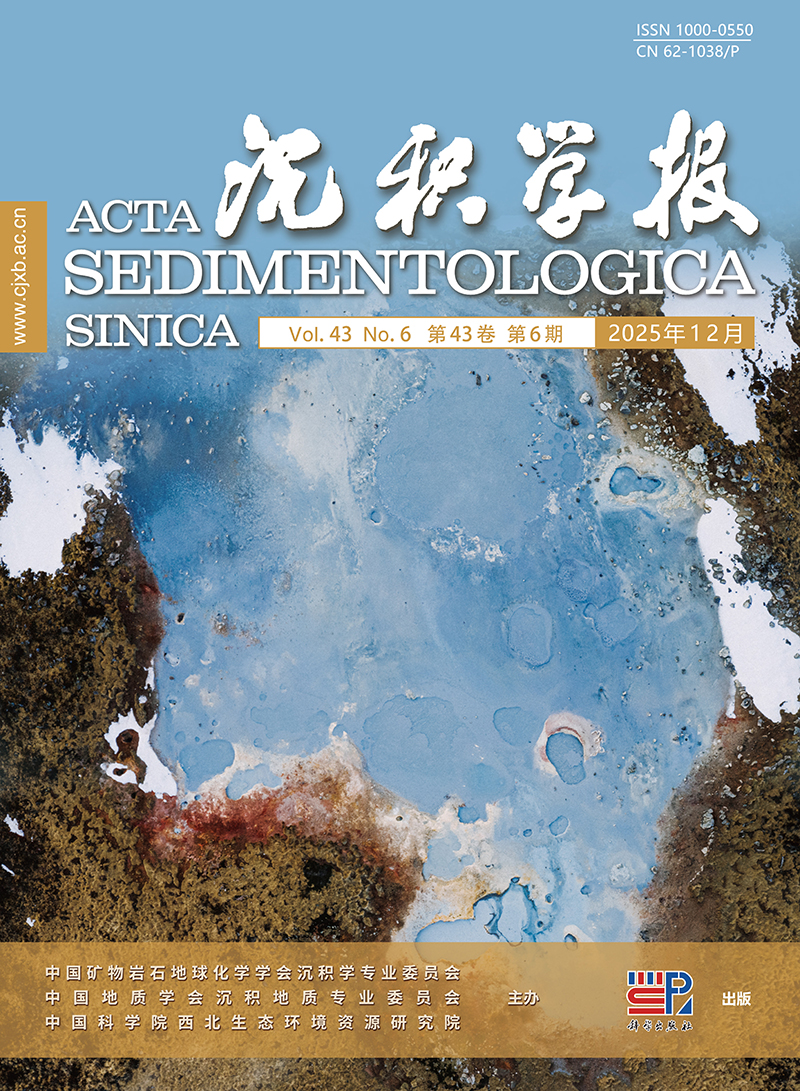1994 Vol. 12, No. 1
中国南方泥盆纪是加里东构造旋回后沉积在前陆盆地基底(华南统一陆块)上的盖层。为一套向上交深的倒置的楔形体,堆积在两侧受挟持的南北向空间内。泥盆系露头层序地层有三个突出的特点:具河流回春的低水位碎屑扇形体做为盆地内早期充填物,代表盆地基底与上覆层之间存在构造变动和海平面相对下降的信息;标志海平面上升到最高点的低速沉积物,以瘤状泥岩、瘤状灰岩和生物层叠加超覆在浅水台地上;高水位沉积体系和海平面相对下降时,台地转为陆上暴露环境,形成南北展市约200km的碳酸盐喀斯特,古溶蚀空间成为有用元素最有利的运移通道和卸截场所。
笔者近几年在柴达木、准噶尔、鄂尔多斯、华北和南宁等盆地从事地震地层学和层序地层学研究工作中,建立了“沉积盆地地震─层序地层学研究辅助系统”(ASeismic─Sequence Stratigraphy Supplementary System of Sedimentary Basins,简称4S)。4S由三大区块组成,即勘探信息数据库,数据综合分析处理与建立定量模型和模型展开并平面、二维及三维成图。4S是一个由4万余条源语句组成的微机软件系统,能够对含油气盆地的地表地质、地震、钻井测井、样品分析测试等数据进行综合分析处理,定量研究目标层序的沉积相,沉积体系,古水流方向,烃类和生储盖层分布预测,沉积体系二维地层模型的地展模拟,沉积层序三维水平切片及其表面地貌形态成像等许多地震─层序地层学所涉及的问题。4S所使用的数据种类和目标结果都不同于目前各种地震资料解释专用系统和盆地模拟系统,并且具有所需设备简单,便于普及和能够解决多种基础地质问题等特点。
三里峡晚泥盆世生物礁厚180m,东西宽4km,由东往西可分出礁前、礁核、礁坪和礁后亚相,为一南北向延伸的线性障壁礁体,往南与月西、公馆等地礁灰岩构成南北向生物礁带。生物礁形成于盆地活化期地垒式台地边缘,经历了滩礁期、发展期、全盛期和衰亡期。同沉积断裂活动产生了有利礁相沉积的海底地貌隆起,礁体的快速生长加剧了古地貌的差异和岩相分异,形成礁后局限成矿盆地。
辽东太子河流域中石炭统本溪组中发现了若干个生物礁。造礁生物为Chaetetes Penchiensis和Arach nastraeaman chrita。太子河流域的几个生物礁在生物组成、造礁方式和礁石特征等诸方面完全一致。在宏观上呈不连续天带状展布。与区域沉积相带展布方向相同。因此,本文认为它们同属一个岸礁体系。
Analyses of the deposit-genetic mark in typical coal-bearing members have shown that Taiyuan Formation (C2) in the southern part of North China represents a complete tidal flat-depositional system, consisting of subtidal flat (subtidal zone), strand flat (intertidal lone-well developed) and supratidal flat (supralittoral zone),which belong to the typical coal-forming model of barrier-tidal flat-lagoon.Shanxi Formation (P11) represents a comparatively complete delta-depositional regine,consisting of prodelta. delta front and delta plain, which belongs to the typical coal-forming model of delta. While longtan Formation (P2) in the South of china mainly represents the coal-forming model of barrier-tidal flat-lagoon with well developed lagoon deposit. Through the researches above, three kinds (four categories) of coal factes are devided based upon reductibility, which is the integrated mark of charactering coal-forming environment (by a series of indexes). These coal facies with their character revealed respectively are I1-Sapropelic coals or humic-sapropelic coals of strong type-reductibility,I2-Humic coals or humic-sapropelic coal in rich-liptinites/rich-perhydrous vitrinites of strong type-reductibility,Ⅱ-Humic coals of stronger type-reductibility and Ⅲ-Humic coals of weak type reductibility,A series of indexes above contain total sulfur,index of ash composition,total iron,Fe++,B/ Ga,Sr/Ba,F/Cl,Palaeosalinity,isotopes of carbon,isotopes of sulfur,Eh,pH,alkane chromatography (the ratio of Aliphatic hydrocarbon to Aromatic hdrocarbon,carbon number of main peak,C21-/C2+ 21 and Pr/Ph),biomarker of alkane (Quantity of terrigenous higher plants/amount of organisms source,Quantity of lower plants source/amount of organisms source,hepanes/terrigenous terpenoids and steroids/hopanes ratio) and biomarker of Aromatic hydrocarbon (dibenzothiopene/tri-fluorene and benezonthracene/chrysene ratio).
Authers suggest that coals of different type-reductibility be characterized respectively by constituent of plants sources,organic and inorganic mather as well as properties of chamistry-technology-generating hydro carbon.Reductibility of coal (i.e. type-coal) may be of both characterizing coal-forming environment and feature of Quality-coal.It is by reductibility that environment is connected with Quality-coal.Therefore,the genetic model of environment-type-coal-Quality-coal build-up.
Authors thinks of coal-facies as total generality of sedimentary environment in peat-forming bog and must implicate environment,type-coal and Quality-except coal rank.
Authors advocate that from the point of view in practice(prediting environment and estimating Quality coal),coal facies are researched and therefor,the regine of "practice coal facieology" should be set up,whose aim is to push the advance of coal-geology,coal-petrology and serve energy sources industry.
The study in this regine of both theoretical and practical importance.
合山煤田主采煤层底板发现古土壤层,在煤分层之间又发现稳定的陆相根土层,结合煤本身的微量元素含量分析,并与现代咸水植物及现代淡水植物的微量元素含量对比,对这种夹在海相碳酸盐岩中的煤层的成因有了新的认识。作者认为,主采煤层与其间接底板碳酸盐岩间存在沉积间断;合山组含煤岩系中可见规模极小的孤立的海绵小礁块,这些都是碳酸盐台地表面浅水环境常见的特征。分析黔桂两省大面积古地理背景,作者认为,合山煤田主采煤层形成于碳酸盐台地表面废弃潮坪上发育的泥炭沼泽,少数地段则是在碳酸盐台地表面闭塞水体进一步沼泽化的条件下形成的。
本文以布郎意-蒙索盆地厚度达40m的第一煤层为单元,根据煤样光片光泽、色彩及组构划分出八类煤相。用有机岩石学方法及热解分析法详细研究了这些煤相。结果表明该煤层主要为微异地-异地沉积,生源输入以木本植物为主;煤层内部也存在类似煤系地层那样的旋回沉积,其原因推测为泥炭非均一性引起差异压缩;煤相的变化主要由水动力条件及水平面高低引起.这种变化明显影响了显微组合的物理一化学性质,如镜质体反射率、孢子体荧光及煤相的氢指数。该研究还指出了各种沉积环境标志物的可靠性。关键词
本文采用镜质体反射率、包裹体测温、磷灰石裂变经迹等多种古地温研究方法,确定了鄂尔多斯盆地中生代晚期高地温场的存在,古地温梯度高达3.5~4.0℃/100m,高于现今盆地的平均地温梯度2.89°C/100m。古生界地层最大古地温一般在150~240°C之间,最高可达270°C以上,古地温明显高于今地温。高古地温梯度的形成与中生代末期的构造活动密切相关。根据盆地热演化史与油气关系研究可知,在古生代和中生代早期,地温梯度低。推迟了生气时代,有利于有机质的保存。中生代晚期,地温梯度高,是古生界碳酸盐岩及煤系地层的主要生气期及运移期。生气高峰期较晚,盆地内又缺乏断裂,有利于大气田的保存。
塔里木盆地寒武-奥陶系碳酸盐岩深部溶蚀的主要特征是非组构选择性、多沿缝合线及裂隙发育。深部溶蚀的主要依据是,溶蚀了晚期成岩组构或溶蚀沿晚期成岩组构(缝合线及裂隙)进行,其中充填烃类或其他晚期成岩矿物,同时不仅在地腹区,而且在早期连续沉降(∈-P1)、后期抬升成陆(P2-Q)的柯坪露头区具此特征。本区深部溶蚀作用主要与生油岩有机质热成熟过程中产生的二氧化碳所形成的酸性水有关。
盐溶作用使碳酸盐岩孔隙性增加,同时在古代碳酸岩中由于渗-潜流水对已成孔隙产生沉淀,在滞流区又可形成致密性岩性遮挡。石盐结晶发生在沉积期,是被溶蚀的沉积易溶母质。盐溶孔的大量发育形成于后表生成岩期。天然气产量和岩石的物性取决于盐溶孔的开启程度。充填程度差异在区域上可导致储层孔隙空间的差异性和非均质性,正是由于岩石的这一自身“亏空”和“补偿”形成了区域上成岩圈闭或岩性遮挡。
An abundance of heavy oil resources is contained in the North western Margin of Junggar Basin. Given GC/MS analyses of saturates and aromatics within its mainly developed areas, it shows a different biodegradation in place to place and ocrresponding to its differential compositions. To the former, an analysis with GC/MS suggests that most degradutions for n-alkanes and branched alkanes occurred, but steroids and terapane and so on cyclic hydrocarbon are well preserved in it in these areas except Feng-cheng area and Tuzigou area. To the latter, a similar feature occured with the saturates, also having an alternative microbial erosion to it from the features of Naphthalene, Phenanthrene, Tri-aromatic steroids (fragment) that is absorbed in order in preference of light aromatics followed by heavy aromatics. In identical numbers of carbon to them, they have more poweful biodegra dation-resisted capability than that of the saturates.
Based on the distribution of each biomarker in the heavy oils existing variable degradstious, these biomarkers in the saturates and aromatics of this capability successivly as follows:n-alkanes, alkyl-cyclo hexne (methyalkyl-cyclohexhe), isoprenoids hydrocarbons steroids(20R),γ-carotane, β-carotane, Bicyclic sesquiterpenes light aromatic (Naphtalene),steraids (20S),steroids (αββ), weight aromatic (phenanthrene),C2l - steroids (C22 - steroids), hopanes,tricyclic terapane, rearranged, sterane,deme thyaled hopanes, with more poweful capability of garmacerane, and tri-aromatic steroids.
In view of this order integrated with the features of the heavy oil studied,a classification of its biodegradation into following five ranks:
1 ) Stight biodegradation. It occured in district Ⅳ - 2 and Heiyonshan (Triassic), having 22. 5-27. 5°API oil.
2) Low biodegradation.It occured in district Ⅵ(Jurassic), having 19-24°API oil.
3) Intermediate biodegradation.It occured in district Ⅸ (Juraasic),having 16-21° API oil.
4) High biodegradation.It occured in Fengcheng(Jurassic), having 11.5-17. 5°API oil.
5) Superhigh biodgradation.It occured in Thou(Jurassic), the tar sand has a gravity below 13° API.
本区早石炭世,秦岭海域海水以天水-静宁古海峡为通道侵入本区,向北、西超覆,形成“¬”型海湾环境,沉积了以海湾-泻湖微相及潮坪相为主夹少量碳酸盐台地相含煤岩系。晚石炭世,海侵进一步扩大,红土洼期-羊虎沟期为“¬”字型海湾;太原期,北祁连海与华北、华南及天山海域连成一片,沉积了滩相、潮坪相及三角洲相为主的含煤岩系。沉积作用向银川以北、武威以西超覆。
本文论述了昌黎海岸风成沙丘的分布与形成特征、层理构造及其沙丘表面沙波发育情况.并对其成因进行了探讨.沙丘迎风坡表面普遍发育有风成沙纹,层理构造非常发育,有低角度交错层理、大型板状交错层理。海岸沙丘沉积物主要来自滦河.滦河入海泥沙在偏风浪的作用下向北搬运并堆积在海滩上.强劲的向岸风使海滩沙向陆搬运建造成海岸沙丘。目前.沙丘仍在活动之中。
湘中地区中奥陶统黑色岩系稀土元素地球化学特点为稀土丰度高轻稀土富集,重稀土亏损,无负Ce异常,Eu负异常明显并有高的∑LREE/∑HREE、La/Yb、(La/Yb)n特征值等,是一种被动大陆边缘缺氧盆地的产物,其沉积物的稀土元素地球化学特点受沉积速率、搬运方式、物源供给等因素的影响。
研究我国干旱半干旱区第四纪黄土剖面中镁铝含量比(m值)的变化特征及所反映的古气候古环境意义。表明黄土-古土壤的m值大小变化反映出黄土堆积-古土壤发育时期的气候干湿变化。
本文从西藏扎仓茶卡和青海大小柴旦盐湖现代沉积的硼酸盐矿物中.纯化得到符合理论化学组成的纳硼解石.获得它的红外光谱图,X射线粉末衍射圈和DSC、DTA热分析图,讨论了热行为.给出了它在水中的溶解度和热力学函数。


